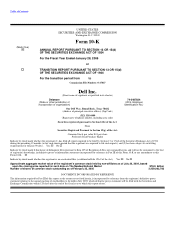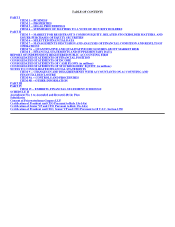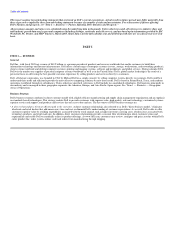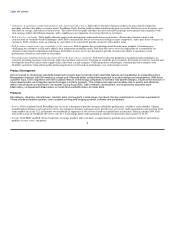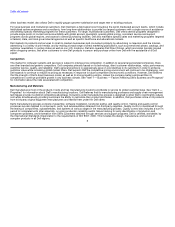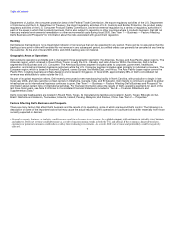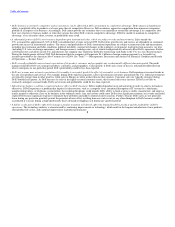Dell 2004 Annual Report Download - page 12
Download and view the complete annual report
Please find page 12 of the 2004 Dell annual report below. You can navigate through the pages in the report by either clicking on the pages listed below, or by using the keyword search tool below to find specific information within the annual report.
Table of Contents
characteristics. Product transitions present some of the greatest execution challenges and risks for any technology company. Accordingly, if Dell is unable to
effectively manage a product transition, its business and results of operations could be negatively affected. In addition, continuing technological
advancement, which is a significant driver of customer demand, is largely beyond Dell's control.
• Disruptions in component availability could unfavorably affect Dell's performance. Dell's direct business model gives it the ability to operate with reduced
levels of component and finished goods inventories. Dell's financial success in recent periods has been due in part to its supply chain management practices,
including its ability to achieve rapid inventory turns. However, because Dell maintains only minimal levels of component inventory, Dell's financial
performance, as well as its ability to satisfy customer needs, could be negatively affected if it suffers a disruption in component availability.
• Dell's reliance on suppliers creates risks and uncertainties. Dell's manufacturing process requires a high volume of quality components that are procured
from third-party suppliers. Reliance on suppliers, as well as industry supply conditions, generally involves several risks, including the possibility of
defective parts (which can adversely affect the reliability and reputation of Dell's products), a shortage of components and reduced control over delivery
schedules (which can adversely affect Dell's manufacturing efficiencies), and increases in component costs (which can adversely affect Dell's profitability).
• Dell could experience manufacturing interruptions, delays, or inefficiencies if it is unable to timely and reliably procure components from certain single-
sourced suppliers. Dell maintains several single-source supplier relationships, either because alternative sources are not available or the relationship is
advantageous due to performance, quality, support, delivery, capacity, or price considerations. If the supply of a critical single-source material or component
were delayed or curtailed, Dell's ability to ship the related product in desired quantities and in a timely manner could be adversely affected. Even where
alternative sources of supply are available, qualification of the alternative suppliers and establishment of reliable supplies could result in delays and a
possible loss of sales, which could adversely affect operating results.
• Dell's results may be affected if it does not effectively hedge its exposure to fluctuations in foreign currency exchange rates and interest rates. Dell utilizes
derivative instruments to hedge its exposure to fluctuations in foreign currency exchange rates and interest rates. Some of these instruments and contracts
may involve elements of market and credit risk in excess of the amounts recognized in the Consolidated Financial Statements. For additional information
about risk on financial instruments, see "Item 7 — Management's Discussion and Analysis of Financial Condition and Results of Operations — Market
Risk." Further, Dell may experience a decrease in revenue from its international operations if it is does not effectively hedge its exposure to currency
fluctuations.
• Dell's continued business success may be largely dependent on its ability to obtain licenses to intellectual property developed by others on commercially
reasonable and competitive terms. If Dell or its suppliers are unable to obtain desirable technology licenses, Dell could be prohibited from marketing
products, could be forced to market products without desirable features, or could incur substantial costs to redesign its products, defend legal actions, or pay
damages.
• Dell's failure to attract and retain qualified personnel could lead to a loss of revenue or profitability. Dell cannot provide any assurance that it will succeed
in attracting and retaining enough qualified personnel to support its anticipated rapid international growth and its increasingly complex product and service
offerings. Dell relies in part on the granting of equity awards to attract and retain qualified personnel. New accounting regulations regarding the expensing
of stock options may affect both Dell's ability to successfully attract and retain qualified personnel and increase Dell's compensation costs.
9


